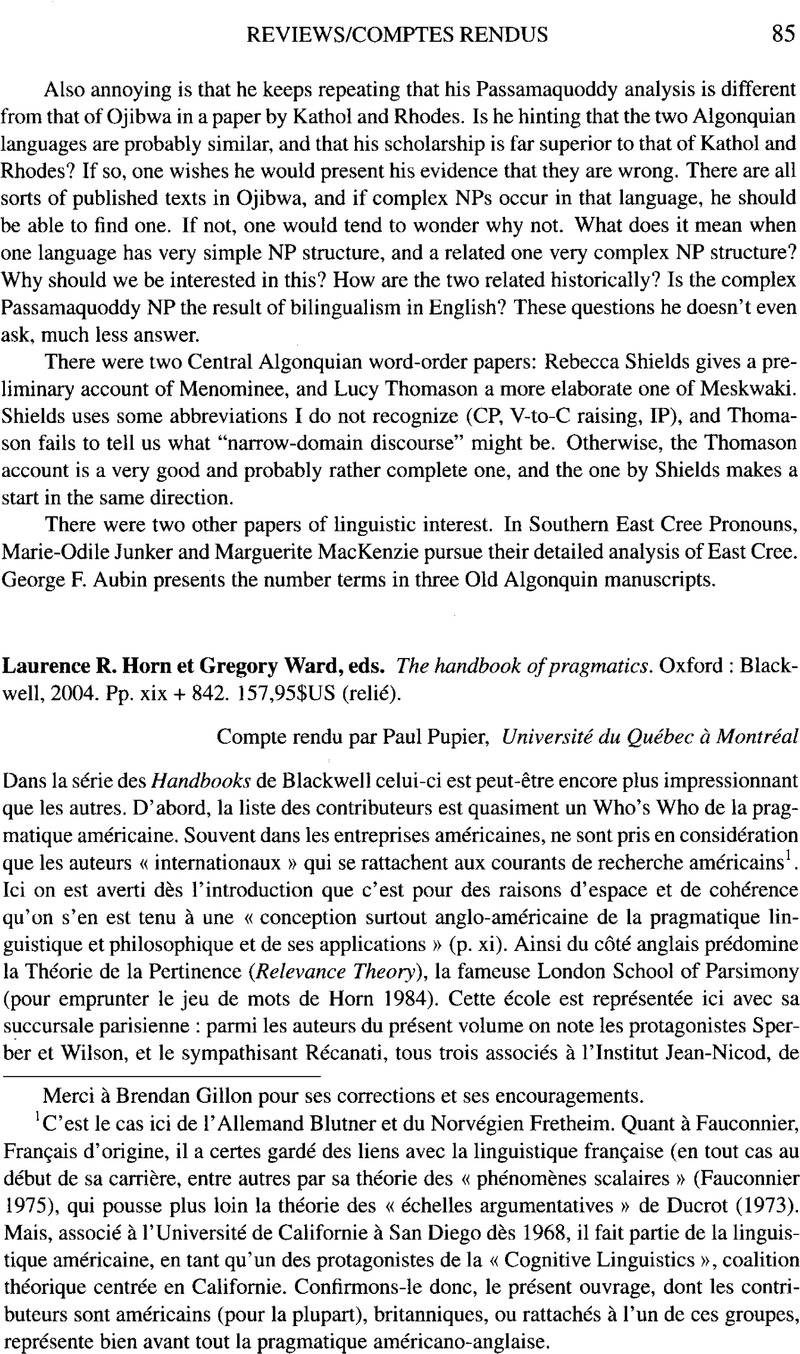No CrossRef data available.
Article contents
Laurence R. Horn et Gregory Ward, eds. The handbook of pragmatics. Oxford : Blackwell, 2004. Pp. xix + 842. 157,95$US (relié).
Review products
Laurence R. Horn et Gregory Ward, eds. The handbook of pragmatics. Oxford : Blackwell, 2004. Pp. xix + 842. 157,95$US (relié).
Published online by Cambridge University Press: 27 June 2016
Abstract
An abstract is not available for this content so a preview has been provided. Please use the Get access link above for information on how to access this content.

- Type
- Reviews/Comptes rendus
- Information
- Canadian Journal of Linguistics/Revue canadienne de linguistique , Volume 51 , Issue 1 , March 2006 , pp. 85 - 94
- Copyright
- Copyright © Canadian Linguistic Association/Association canadienne de linguistique 2006
References
Références
Asher, Nicholas et Lascarides, Alex. 2003. Logics of conversation. Cambridge: Cambridge University Press.Google Scholar
Beaver, David. 2001. Presupposition and assertion in dynamic semantics. Stanford: Center for the Study of Language and Information.Google Scholar
Clark, Eve V. 1993. The lexicon in acquisition. Cambridge: Cambridge University Press.10.1017/CBO9780511554377Google Scholar
Clark, Herbert. 1996. Using language. Cambridge : Cambridge University Press.10.1017/CBO9780511620539Google Scholar
Fauconnier, Gilles. 1975. Pragmatic scales and semantic structure. Linguistic Inquiry 6:353–375.Google Scholar
Horn, Lawrence. 1984. Ambiguity, negation, and the London School of Parsimony. NELS 14:108–131.Google Scholar
Hume, David. 1999. An enquiry concerning human understanding. Sous la dir. Beauchamp, de Tom L.. New York : Oxford University Press. [1748]Google Scholar
Kasper, G. 1997. Linguistic etiquette. In The handbook of sociolinguistics, ed. Coulmas, Florian, 374–385. Oxford: Blackwell.Google Scholar
Kuno, Susumu. 1987. Functional syntax : Anaphora, discourse and empathy. Chicago : University of Chicago Press.Google Scholar
Levinson, Stephen. 1987. Explicature explicated. Behavioral and Brain Sciences 10:722–723.10.1017/S0140525X00055473Google Scholar
Levinson, Stephen. 1989. Relevance. Journal of Linguistics 27:107–161.10.1017/S0022226700012433Google Scholar
Levinson, Stephen. 2000. Presumptive meanings. Cambridge, MA: MIT Press.10.7551/mitpress/5526.001.0001Google Scholar
Levinson, Stephen. 2003. Space in language and cognition. Cambridge: Cambridge University Press.10.1017/CBO9780511613609Google Scholar
Milsark, Gary. 1977. Toward an explanation of certain peculiarities of the existential construction in English. Linguistic Analysis 3:1–29.Google Scholar
Moeschler, Jacques et Reboul, Anne. 1994. Dictionnaire encyclopédique de pragmatique. Paris: Seuil.Google Scholar
Morris, Charles W. 1938. Foundations of the theory of signs. Chicago: University of Chicago Press.Google Scholar
Sperber, Dan et Wilson, Deirdre. 1995. Relevance : Communication and cognition. 2nd ed. Oxford : Blackwell.Google Scholar




